
© » KADIST
Juan Capistran
The 10 $1 bills that make up From a Whisper to a Scream (2012) read like instructions in origami. From left to right, each bill is progressively folded up, step by step, into the shape of a gun. Both a scream and a whisper are capable of conveying the same content, if at drastically different decibels, the artist proposes.

© » KADIST
Juan Capistran
The Breaks reflects Capistran’s interests in sampling and fusing different cultural, social, and historical sources. Growing up in an African-American community in Los Angeles, Capistran has long been influenced by hip-hop culture. The photographs in this print document him surreptitiously breakdancing on Carl Andre’s iconic lead floor piece after the guards at the Los Angeles County Museum of Art have left the gallery.

© » KADIST
Lisa Oppenheim
Drawing & Print (Drawing & Print)
The Damaged series by Lisa Oppenheim takes a series of selected photographs from the Chicago Daily News (1902 – 1933) as its source material. For this project, Oppenheim procured the original glass negatives, which had been damaged over time, from the archives of this newspaper. She then printed the negatives as is, highlighting the multitude of physical flaws that had ‘spoiled’ the negatives.
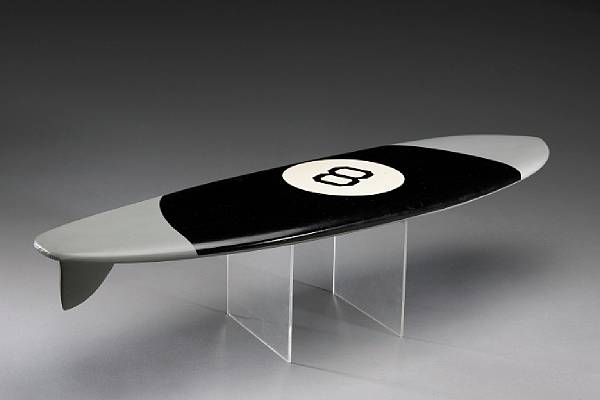
© » KADIST
Alexis Smith
In 8 Ball Surfboard (1995),Alexis Smith combines her long-term interests in California culture and conceptual assemblage. The surfboard, an emblem of Southern California, emblazoned with the image of an eight-ball, references numerous tropes and clichés of American popular culture, specifically subcultures related to pool halls, surfing, and beaches. Indeed, this model-scale surfboard may be a future pop-culture relic, referencing a particular surfer or era of board design.

© » KADIST
Lisa Oppenheim
Drawing & Print (Drawing & Print)
The Damaged series by Lisa Oppenheim takes a series of selected photographs from the Chicago Daily News (1902 – 1933) as its source material. For this project, Oppenheim procured the original glass negatives, which had been damaged over time, from the archives of this newspaper. She then printed the negatives as is, highlighting the multitude of physical flaws that had ‘spoiled’ the negatives.

© » KADIST
Tuan Andrew Nguyen
This work presents the image of an immolated monk engraved on a baseball bat. The flames surround him eroding the extremity of the bat. The delicate sculpture refers to the sacrifice of the Buddhist monk, Thich Quang Duc, who immolated himself on June 16th 1963, in reaction to the discrimination and the repressive politics of the Diem Catholic regime (regime installed by the Americans) towards the Buddhists.
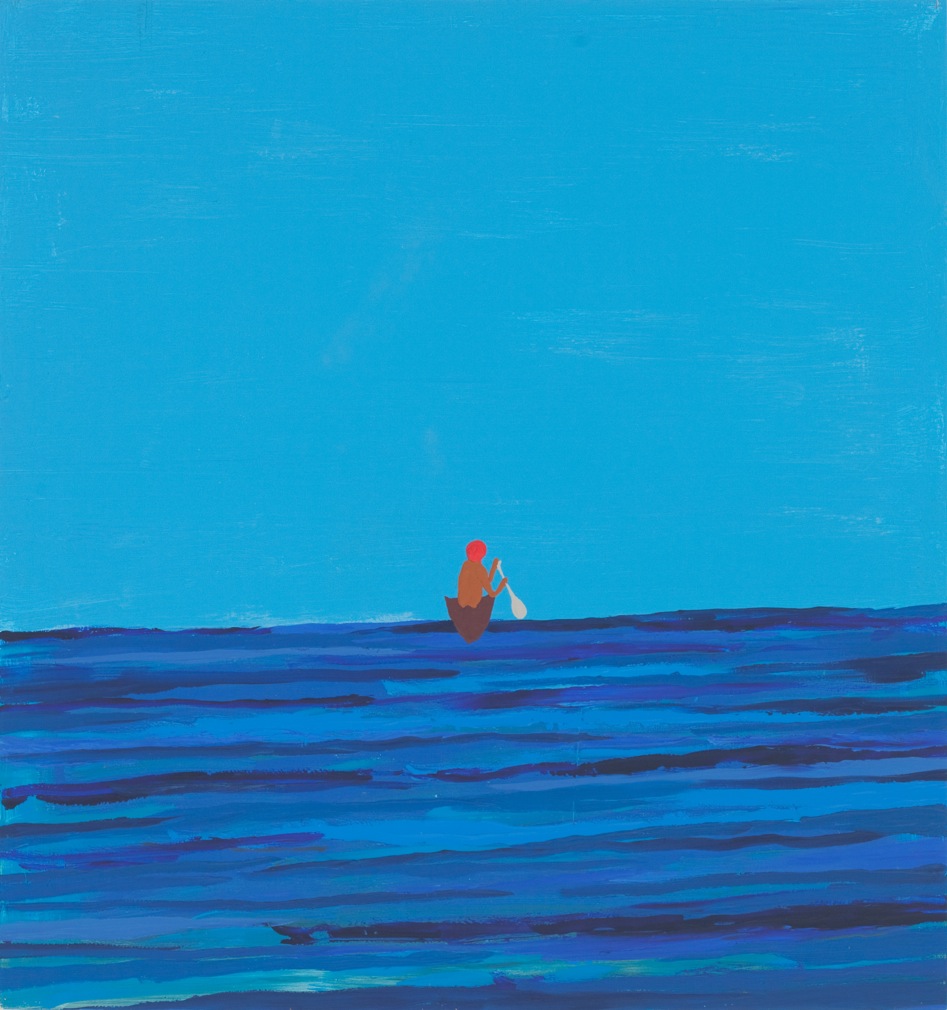
© » KADIST
Chris Johanson
Chris Johanson’s Untitled (Painting of a Man Leaving in Boat) (2010) pictures a canoe drifting toward an off-kilter horizon line, which demarcates the cobalt sea from the cerulean sky. An orange-haired figure, oar positioned in mid-stroke, looks ahead—whether toward an edge or an infinite expanse, it is impossible to tell. Echoing a trope that recurs in Greek epic poetry, transcendental painting, and current-day reality television, the character is alone with nature.
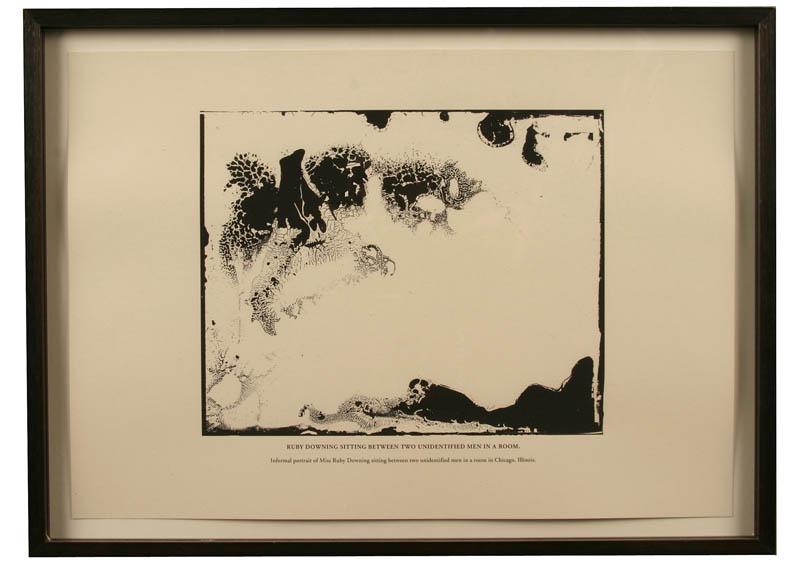
© » KADIST
Lisa Oppenheim
Drawing & Print (Drawing & Print)
The Damaged series by Lisa Oppenheim takes a series of selected photographs from the Chicago Daily News (1902 – 1933) as its source material. For this project, Oppenheim procured the original glass negatives, which had been damaged over time, from the archives of this newspaper. She then printed the negatives as is, highlighting the multitude of physical flaws that had ‘spoiled’ the negatives.

© » KADIST
Barry McGee
Barry McGee’s Untitled is a collection of roughly fifty, framed photographs, paintings, and text pieces clustered together in corner. Its tiled effect can perhaps be seen as a vertical Carl Andre work and also bears some resemblance to another work in the Kadist Collection, Jedediah Caesar’s JCA-25-SC. McGee’s installation also echoes the votive altars in the chapels he visited during his residency in Brazil in 1993.

© » KADIST
Aaron Young
The artist describes the work as “very performative video-pieces but they take on a more sculptural feel. The action is simple: I kick a video camera through a site that is embedded with sociological elements, which I try to question through my practice. I chose Red Square as the site to work in Moscow.
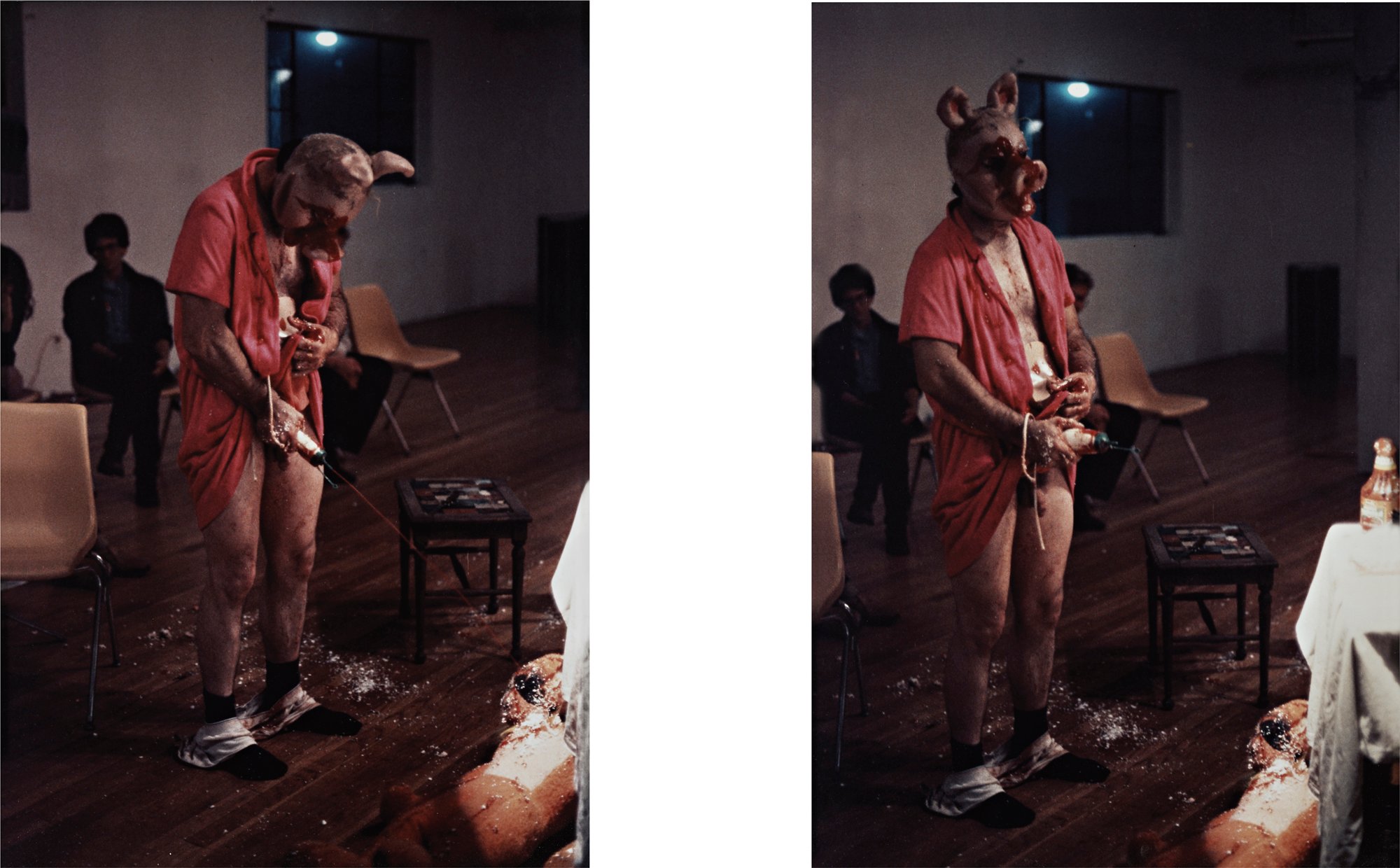
© » KADIST
Paul McCarthy
McCarthy’s Mother Pig performance at Shushi Gallery in 1983 was the first time he used a set, a practice which came to characterize his later works. Here, McCarthy squirts liquid out of a bottle held near his crotch onto a stuffed animal in the shape of a lion. The costuming, materials, and simulated bodily functions frequently appear in McCarthy’s work, which often disturbingly juxtaposes visceral and startling manipulation of the body with the cheerful artifacts of popular consumer culture.

© » KADIST
Chris Johanson
Chris Johanson’s paintings, sculptures, and installations break down everyday scenes and commonplace dramas into colorful forms; the darkest sides of humanity are invoked with humor. The works comment on subjects such as capitalism, consumerism, the art world, and therapy. The triptych I Am a Human, Abstract Foil, No Humans IV (2004) is a meditation on the cosmos.

© » KADIST
Chris Johanson
Apartment on Cardboard (2000) is an exterior view of an abstracted apartment building. Viewers unwittingly become voyeurs, peering through the rectangles that stand for windows and observing the residents therein, who ponder questions both mundane and existential: “Where is Ron now?” and “What have I become?” The queries and characters are treated democratically—not judged, praised, or subjected to hierarchy. While their thoughts are specific, the painting captures a universal urban activity: looking across to the building next door and wondering about its residents, all the while knowing that they have probably looked over and wondered about us, as well.
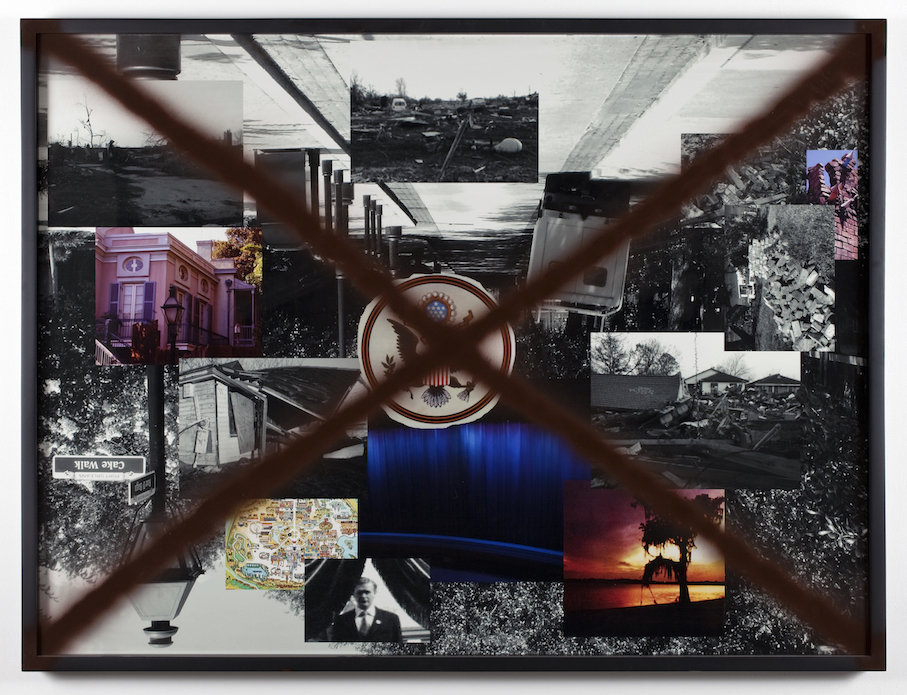
© » KADIST
Stephen G. Rhodes
For his series of digital collages Excerpt (Sealed)… Rhodes appropriated multiple images from mass media and then sprayed an X on top of their glass and frame. This visual seal refers to the disastrous aftermath of Hurricane Katrina in 2005 in which rescue workers spray painted the doors of the houses they searched giving the date, the team and the number of bodies found. Excerpt (Sealed) (Brown) is a multilayered collage with contradictory imagery—from New Orleans debris to the American eagle and a theater curtain.

© » KADIST
Alexis Smith
Iron Sorrows (1990) brings together what are for Alexis Smith common motifs and materials such as scavenged and repurposed metal, and street signage. Iron is one of nature’s most abundant metals. Smith, a philosopher of human detritus and poetic associations, presents it in this work as simultaneously everywhere yet paradoxically forgotten, lost in the heaps of refuse that fill junkyards and vacant lots.

© » KADIST
Jeffrey Vallance
Vallance’s Rocket is a vibrant picture in which masses of color and collage coalesce into a central vehicle, yet the whole surface seems lit with the roar of space travel. This varied use of media has enabled the artist to bring all of the life, energy, and objects he works with into a single image.

© » KADIST
Gregory Crewdson
Forest Gathering N.2 is part of the series of photographs Beneath the Roses (2003-2005) where anonymous townscapes, forest clearings and broad, desolate streets are revealed as sites of mystery and wonder; similarly, ostensibly banal interiors become the staging grounds for strange human scenarios. These scenes are tangibly atmospheric, visually alluring and often deeply disquieting. Never anchored precisely in time or place, these and the other narratives of Beneath the Roses are rather located in the dystopic landscape of the anxious American imagination.

© » KADIST
Karl Haendel
Drawing & Print (Drawing & Print)
Haendel’s series Knights (2011) is a set of impeccably drafted, nine-foot-tall pencil drawings depicting full suits of armor. The series riffs on previous investigations by the artist such as his meticulous depictions of masculine political figures, which included a headless J. Edgar Hoover and a Hitler head floating vulnerably in the center of a white expanse (Hitler’s iconic mustache was crafted from the artist’s pubic hair). Rendered in soft graphite, the imposing Knights embody the ostensibly conflicting ideals of chivalrous deference and invulnerable masculinity.

© » KADIST
Juan Capistran
White Minority , is typical of Capistran’s sampling of high art genres and living subcultures in which the artist subsumes an object’s high art pedigree within a vernacular art form. Here, Capistran humorously remixes the form and style of Frank Stella’s Black Paintings with California punk rock band Black Flag’s song title and logo (created by artist Raymond Pettibon). White Minority , then, appropriates, recontextualizes, and riffs on language and visual signs to unmoor notions of identity, power, and revolution.
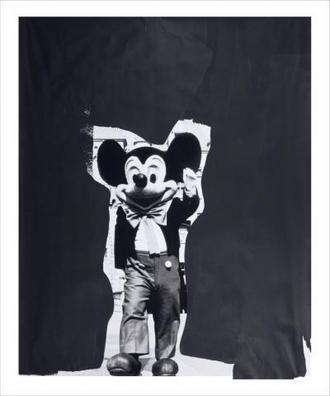
© » KADIST
Paul McCarthy
Drawing & Print (Drawing & Print)
To make Mickey Mouse (2010), Paul McCarthy altered a found photograph—not of the iconic cartoon, but of a man costumed as Mickey. On his shoulders he supports an enormous false head, Mickey’s familiar face grinning with glossy eyes. The artist has marked out in heavy black the background of Cinderella’s castle.

© » KADIST
Paul McCarthy
Memory Mistake of the Eldridge Cleaver Pants was created for the show Paul McCarthy’s Low Life Slow Life Part 1 , held at California College of the Arts’s Wattis Institute in 2008 and curated by McCarthy himself. In homage to an influence in his early career, McCarthy attempted to reconstruct a pair of pants worn by Black Panther revolutionary Eldridge Cleaver in a picture that appeared in Rolling Stone magazine in the 1970s. But in the process, McCarthy misremembered their original design of the pants, which had black outer panels and white inner panels in white, and left a black shape highlighted in the crotch area.
Paul McCarthy
- location: Los Angeles, California
- year born: 1945
- gender: male
- nationality: American
- home town: Salt Lake City, Utah
Chris Johanson
- location: Los Angeles, California
- year born: 1968
- gender: male
- nationality: American
- home town: San Jose, California
Juan Capistran
- location: Los Angeles, California
- gender: male
- nationality: Mexican American
- home town: Guadalajara, Mexico
Lisa Oppenheim
- location: New York, New York
- year born: 1975
- gender: female
- nationality: American
- home town: New York, New York
Alexis Smith
- location: Los Angeles, California
- year born: 1949
- gender: female
- nationality: American
- home town: Los Angeles, California
Tuan Andrew Nguyen
Tuan Andrew Nguyen is an artist and filmmaker, one of the three founders of The Propeller Group created in 2006...
Stephen G. Rhodes
- location: New York, New York
- year born: 1977
- gender: male
- nationality: American
- home town: Houston, Texas
Barry McGee
- location: San Francisco, California
- year born: 1966
- gender: male
- nationality: American
- home town: San Francisco, California
Gregory Crewdson
- location: New York, New York
- year born: 1962
- gender: male
- nationality: American
- home town: Brooklyn, New York
Karl Haendel
- location: Los Angeles, California
- year born: 1976
- gender: male
- nationality: American
- home town: New York, New York
-
1970-1979
Jeffrey Vallance
1978Vallance’s Rocket is a vibrant picture in which masses of color and collage coalesce into a central vehicle, yet the whole surface seems lit with the roar of space travel...
-
1980-1989
Paul McCarthy
1983McCarthy’s Mother Pig performance at Shushi Gallery in 1983 was the first time he used a set, a practice which came to characterize his later works...
-
1990-1999
Alexis Smith
1990Iron Sorrows (1990) brings together what are for Alexis Smith common motifs and materials such as scavenged and repurposed metal, and street signage...
Alexis Smith
1995In 8 Ball Surfboard (1995),Alexis Smith combines her long-term interests in California culture and conceptual assemblage...
-
2000-2009
Chris Johanson
2000Apartment on Cardboard (2000) is an exterior view of an abstracted apartment building...
Juan Capistran
2002The Breaks reflects Capistran’s interests in sampling and fusing different cultural, social, and historical sources...
Lisa Oppenheim
Drawing & Print
2003(Drawing & Print) The Damaged series by Lisa Oppenheim takes a series of selected photographs from the Chicago Daily News (1902 – 1933) as its source material...
Lisa Oppenheim
Drawing & Print
2003(Drawing & Print) The Damaged series by Lisa Oppenheim takes a series of selected photographs from the Chicago Daily News (1902 – 1933) as its source material...
Lisa Oppenheim
Drawing & Print
2003(Drawing & Print) The Damaged series by Lisa Oppenheim takes a series of selected photographs from the Chicago Daily News (1902 – 1933) as its source material...
Chris Johanson
2004Chris Johanson’s paintings, sculptures, and installations break down everyday scenes and commonplace dramas into colorful forms; the darkest sides of humanity are invoked with humor...
Gregory Crewdson
2005Forest Gathering N.2 is part of the series of photographs Beneath the Roses (2003-2005) where anonymous townscapes, forest clearings and broad, desolate streets are revealed as sites of mystery and wonder; similarly, ostensibly banal interiors become the staging grounds for strange human scenarios...
Juan Capistran
2005White Minority , is typical of Capistran’s sampling of high art genres and living subcultures in which the artist subsumes an object’s high art pedigree within a vernacular art form...
Aaron Young
2007The artist describes the work as “very performative video-pieces but they take on a more sculptural feel...
Paul McCarthy
2008Memory Mistake of the Eldridge Cleaver Pants was created for the show Paul McCarthy’s Low Life Slow Life Part 1 , held at California College of the Arts’s Wattis Institute in 2008 and curated by McCarthy himself...
-
2010-2019
Stephen G. Rhodes
2010For his series of digital collages Excerpt (Sealed)… Rhodes appropriated multiple images from mass media and then sprayed an X on top of their glass and frame...
Paul McCarthy
Drawing & Print
2010(Drawing & Print) To make Mickey Mouse (2010), Paul McCarthy altered a found photograph—not of the iconic cartoon, but of a man costumed as Mickey...
Chris Johanson
2010Chris Johanson’s Untitled (Painting of a Man Leaving in Boat) (2010) pictures a canoe drifting toward an off-kilter horizon line, which demarcates the cobalt sea from the cerulean sky...
Karl Haendel
Drawing & Print
2011(Drawing & Print) Haendel’s series Knights (2011) is a set of impeccably drafted, nine-foot-tall pencil drawings depicting full suits of armor...
Tuan Andrew Nguyen
2012This work presents the image of an immolated monk engraved on a baseball bat...
Juan Capistran
2012The 10 $1 bills that make up From a Whisper to a Scream (2012) read like instructions in origami...
